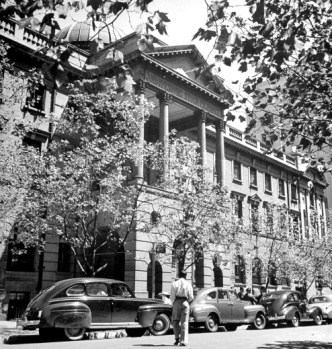
Last year, political strategist and monetary economist Cedric Muhammad said, “At 29-years old and a base of support among the youth and business class, Julius Malema could not be a more important figure to watch as the political and financial marketplaces determine how the nation’s (South Africa) wealth should be distributed and allocated.” Mr. Muhammad is currently a Member of the African Union’s First Congress of African Economists. Evidently, Mr. Muhammad knew what he was talking about.
In a surprising move last September, the ruling African National Congress party decided to study nationalization in response to the repeated requests of Julius Malema, the controversial leader of the party’s Youth League. The decision cast a dark cloud over South Africa’s mining industry.
Citibank analysts estimate that South Africa has more than $2.5 trillion in mineral reserves ranking it the world’s richest nation by commodity wealth, followed by Russia and Australia. According to the Mines Ministry, mining generates 30 percent of South Africa’s export revenue, 18 percent of its corporate taxes and a half a million direct jobs. The country is the world’s biggest producer of platinum and chrome, and the third largest gold producer. Mining companies comprise roughly 43 percent of the value of the Johannesburg Stock Exchange. One would think that given the current resource boom South Africa should be thriving, but frequent labor problems and prolonged power outages have affected the profitability of the mining industry. And Johannesburg’s gold fields, the source of 40 percent of all the gold ever mined, are in decline. Over the last decade, output has shrunk by more than 7 percent a year.
Today, South Africa’s former Reserve Bank governor, Tito Mboweni, stated that he felt the mining nationalization debate was being handled recklessly. Mr. Mboweni said, “The manner in which the issue has been raised has lacked an appreciation for the consensus-building spirit that has informed the construction of new and ongoing agreement in our society.” And last week, Mark Cutifani, CEO of South African major AngloGold Ashanti Ltd. (NYSE:AU) and Vice President of South Africa’s Chamber of Mines, said in a written editorial, “We will not deal with these issues through business simply by shouting louder than the African National Congress Youth League. Young people are justified in calling for broad social change. The logic behind the call for nationalization needs to be sensibly debated rather than angrily dismissed.”
Bridgette Radebe, Chairman of Mmakau Mining and the wife of South Africa’s justice minister, stated at a recent conference that a failure to address the ongoing economic imbalances in South Africa could lead to a “situation like Zimbabwe.” Under Zimbabwe’s Empowerment Act, enacted in 2008, foreign-owned miners must cede or sell 51 percent of their shares to black citizens or state-approved agencies.
Given the ongoing geopolitical instability in South Africa, we look at three high-profile TSX listed mining stocks that are doing business in Africa’s largest economy.
Platinum Group Metals Ltd. (TSX: PTM)
Platinum Group Metals holds significant mineral rights in the Bushveld Complex in South Africa which, from the perspective of platinum, is the place to be. The Bushveld Complex is the world’s largest primary reserve of platinum and South Africa produce’s 80% of the world’s annual platinum production. Platinum, among the rarest and costliest of metals, is also one of the most green. Platinum is so rare that all of the metal ever mined would fill a room measuring less than 25 feet on each side. The metal has many critical commercial uses, but the primary demand driver today is the automotive industry. Catalytic converters that control harmful automobile emissions now account for 60% of the annual demand for platinum.
Shares of Platinum Group Metals have not performed well since the move by the African National Congress party to open the debate on nationalization last September. At the time, the company’s shares were trading up hitting the $2.40 range but have since fallen to under $1.80.
Frontier Rare Earths Ltd. (TSX: FRO)
The nationalization debate didn’t stop the $60 million IPO of Frontier Rare Earths late last year. Frontier is one of many new exploration and development stage companies listed on the TSX trying to stake a future on the red-hot rare earths scene. Frontier’s flagship project is the Zandkopsdrift rare earth element deposit in the Northern Cape province of South Africa. The company’s NI 43-101 technical report states that Zandkopsdrift is one of the largest known undeveloped rare earth deposits outside China. On July 13th, 2011, Frontier signed a heads of agreement with Korea Resources Corporation, the Korean government-owned mining and natural resource investment company, to form a strategic partnership around the company’s Zandkopsdrift project. Terms of the agreement are expected to be finalized in the fourth quarter of 2011.
Frontier Rare Earths was featured by MiningFeeds.com in 5 Most Interesting Rare Earth Stocks – CLICK HERE – for the article. And with South Africa’s nationalization debate heating up of late, things are certainly getting more interesting by the day.
Uranium One Inc. (TSX: UUU)
Uranium One is a mining and exploration company with interests in in South Africa and Australia. Unfortunately for shareholders it appears business hasn’t been going much better in Australia. Sort through Uranium One’s financial statements and you’ll find a $113.5 million writedown at its Honeymoon Uranium project in Australia late last year. But with the Japanese disaster now four months past, the company appears to be making a modest comeback. Shares of the embattled uranium miner are currently trading at $3.16 up nicely from its $2.50 lows reached last month.
For last month’s related article entitled – “Is it time for a uranium sector rebound?” – CLICK HERE.



 Follow us on Twitter
Follow us on Twitter Become our facebook fan
Become our facebook fan











Comments are closed.